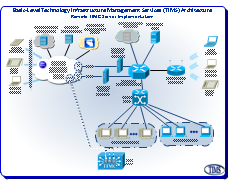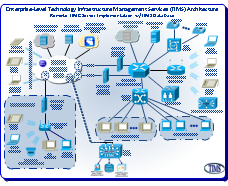|
A technology infrastructure
is defined as the technical
framework that enables the
secure, seamless
interconnection of
end-points devices such as
PCs, MACs, tablets and
smartphones with business
applications and databases
residing on web servers and
cloud server farms. If a
given end-point device or
server does not support the
full TCP/IP protocol stack,
an Internet Protocol (IP)
adapter can be used to
bridge this non-compliant
end-point device and server
to the Technology
Infrastructure.
|
A typical small
Technology
Infrastructures is
composed of the
following
components:
-
A Wide Area Network
(WAN) - such as the Global Internet WAN shown in
this network diagram.
-
A Local Area Networks (LAN) - Routers, Switches, Wireless
Access Points (WAPs),
and other LAN
components.
-
Multiple End-Point Networking (EPD) Devices - PCs, MACs, tablets, smartphones, and other
web-compliant devices.
-
Legacy Servers, Intranet
Servers, and Specializes
Servers used to support
VoIP and Surveillance
Camera Systems.
|
 |
The common thread between all three of these
components is the
IPv4/IPv6 Internet Protocol. The Technology
Infrastructure along with
the Internet Protocol
provides
ubiquitous, anywhere-at-anytime access
to business applications and database
servers attached to the LAN and/or the Global Internet WAN. These applications
and databases are located on:
-
Internet and
Intranet Web Servers.
-
Cloud Computing
Provider (CSP) Servers.
-
Legacy Application
and Database Servers.
Steps for
Converting an Ad Hoc Network into a Managed Technology
Infrastructure
|
There are four steps required to convert
from an unmanaged Ad Hoc Network to a
Managed Technology
Infrastructure:
-
We perform a comprehensive assessment of
your existing networking environment including Internet access,
LAN components, and end-point devices such as servers, PCs,
MACs, notebooks, tablets, and smartphones. This assessment
includes your remote offices and telecommuting employees, if
any. (There is absolutely no charge for this technical
assessment.)
-
Based upon the results of this
assessment, we will prepare a formal proposal for migrating your
existing unmanaged Ad Hoc network into a managed technology
infrastructure. This proposal will include a project plan and
detail costs.
-
If our proposal is accepted, we will
create an inventory database that includes all of your
networking hardware plus your end-point devices such as PCs,
MACs, notebooks, tablets and smartphones. (Click here to see
an example of this database.)
-
If on the other hand, you decide to
accept our proposal, we will immediately start the project and
follow the steps outlined in the plan plan.
In three business days or less, your
new Managed Technology
Infrastructure will be fully operational, and will become the Central Nervous System
of your business. This new cloud-ready technology infrastructure will enable your
business can take full advantages of the cloud computing phenomenon.
|
|
While it may appear to be a
daunting, expensive
proposition to migrate your
existing ad hoc network into our
managed Technology
infrastructure, it is a
relatively simple,
straight-forward process
that can be done in a matter
of days. In most cases, we
can use virtually all of
your existing network
hardware. (The only
mandatory required of our
managed technology
infrastructure is that it
include small-business WAN router that includes integrated
VPN and firewall support.) This
specialized router is
required because if will
become the cornerstone of your
n%20ArchitectureSm.png) ew managed technology
infrastructure, and (it along
with the TIMC) will be
used to manage and monitor
your LAN, WAN, and EPN
devices. Prior to starting
the migration process, we
will create a TIMS database
that contains of your
company's technology
infrastructure components. After the migration
is completed, you will only
be charge a small monthly
fee for the 24/7 monitoring
services performed by our
Technology Infrastructure
Management Console (TIMC).
You should not have to make
any additional investment in
network hardware or software
to support your existing
business requirements. The
following is a partial list of the
management applicatons and
processes provided
by
technology infrastructure management
services: ew managed technology
infrastructure, and (it along
with the TIMC) will be
used to manage and monitor
your LAN, WAN, and EPN
devices. Prior to starting
the migration process, we
will create a TIMS database
that contains of your
company's technology
infrastructure components. After the migration
is completed, you will only
be charge a small monthly
fee for the 24/7 monitoring
services performed by our
Technology Infrastructure
Management Console (TIMC).
You should not have to make
any additional investment in
network hardware or software
to support your existing
business requirements. The
following is a partial list of the
management applicatons and
processes provided
by
technology infrastructure management
services:
-
User Help Desk Support
Including
Single-Point-of-Contact
(SPoC) for all
Network-Related Problem
Management Activities.
-
LAN Design & Optimization.
-
WAN Performance Monitoring.
-
End-Point Networking (EPN).
-
Cloud Computing Integration.
-
Internet/Intranet
Support.
-
Gateway, Client, and PPTP VPN Implementation.
-
Wi-Fi/BYOD Access Security.
-
TIMS Database Creation and Management.
-
Realtime Performance and
Availability Reporting.
How much will it
cost and how long
will the TIMS
implementation
process take?
|
|
Three
Alternative
Technology
Infrastructure
Management Services
(TIMS)
Implementations |
|
Entry-Level
TIMS Implementation |
Basic-Level
TIMS Implementation |
Enterprise-Level
Outsourcing
TIMS Implementation |

Click to view larger
image. |

Click to view larger
image. |

Click to view larger
image. |
|
No up-front
implementation cost. |
No up-front
implementation cost. |
Implementation Cost:
Special Quote. |
|
Recurring
Cost: $99/month. |
Recurring
Cost: $149/month. |
Recurring Cost:
$299/month.
|
Implementation and Recurring
Costs
There is absolutely no
up-front cost for the
Entry-Level and Basic-Level
TIMS implementation, and if
you already have a
TIMS-compliant WAN router, we can convert your existing
ad hoc network into a managed
small-business technology
infrastructure in two
business days or less.
Monthly recurring costs for
the Entry-Level and
Basic-Level TIMS
implantations are $99, and
$199, respectively.
(Please call (623) 979-1827
or (602) 478-4778 for
special quotes for our
Outsourcing-Level TIMS.)
|